Stuffed Mirlitons are a staple of Cajun and Creole cooks. Perfect for stuffing, a mirliton's mild flavor easily takes on the flavors of the other ingredients. Artichoke Stuffed Mirlitons combine the slight lemony flavor of artichoke with the mild flavors of mirliton, the Trinity (yellow onions, celery, and bell peppers), and the Creole-Italian character of Parmesan, Romano, and Fresh Herbs. Seasoned breadcrumbs bring everything together before it's stuffed back into the mirliton shell and baked to a golden perfection. Although not strictly vegetarian, this recipe contains no meat or seafood. Delicious and unbelievably simple.
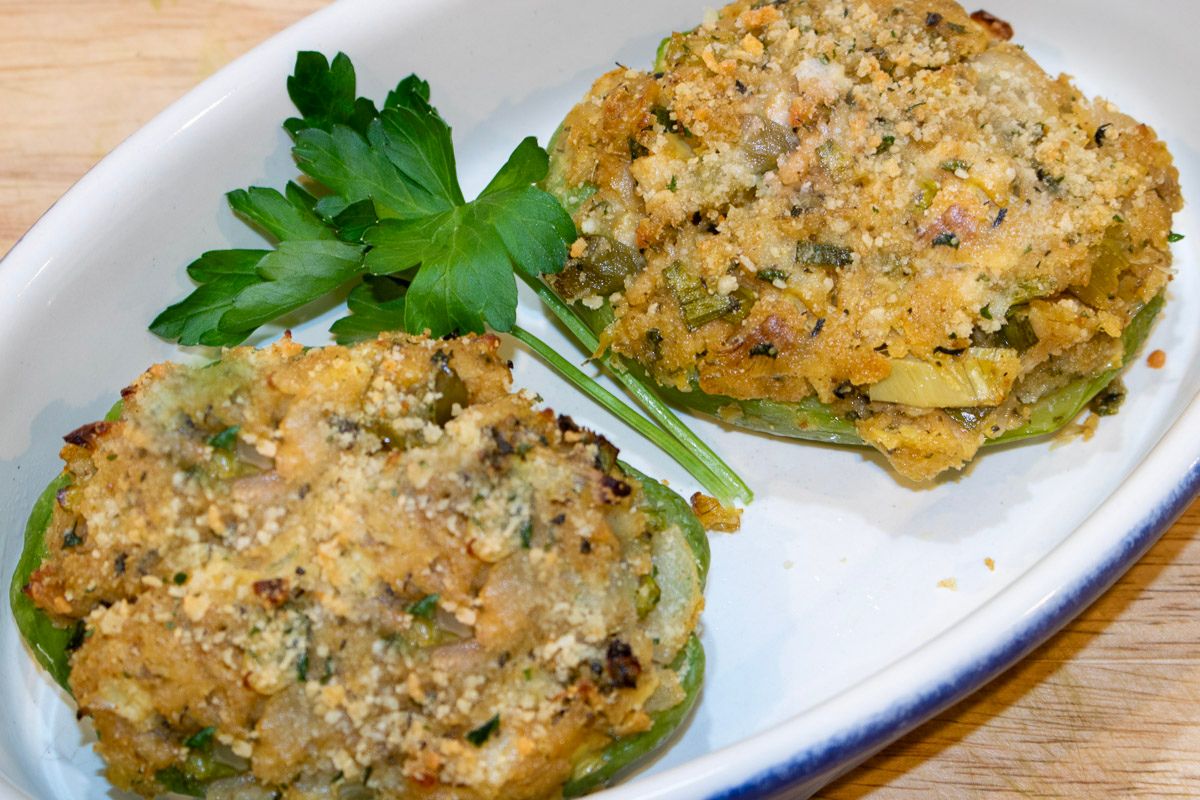
This post is not sponsored, but you will find affiliate links on this page. As an Amazon Associate, I earn from qualifying purchases. The price you pay as a consumer does not change, but I may make a small commission based on your purchase.
Jump to:
What is a Mirliton?
Mirlitons and South Louisiana is a match made in Heaven. If you’re not familiar with a mirliton, you may know them as chayote or vegetable pears. This pear-shaped, light green vegetable is a member of the gourd family, like cucumbers, pumpkins, and squash. Originating with the Aztecs and Mayans, they were introduced to South Louisiana by the Spanish in the mid-18th Century through the Caribbean and Central America. At that time, the predominantly French-speaking population translated the vegetable's name as "mirliton".

Not only did mirlitons flourish in the soil and climate of South Louisiana, but they also fit well into the thinking of Creole and Cajun cooks.
- Mirliton’s mild flavor combines well with the flavors of other ingredients like local meats, seafood, other vegetables, and South Louisiana seasonings.
- Perfect in casseroles and soups (among many other preparations), the hearty vegetable's shape is dying to be stuffed, which happens to be a pastime of Creole and Cajun cooks.
- Mirlitons grow well in South Louisiana soils during cooler months making them a favorite for holiday dishes.
- Mirliton’s popularity almost reaches cult status and is commonly grown in backyard vegetable gardens.
- Mirlitons are commonly found at local produce stands and farmer’s markets.
- Both domestic and imported mirlitons (chayote) are commonly available in grocery stores everywhere in the fall and winter months.
- I contributed to this great article about the cultural value of mirlitons in South Louisiana by Elisabeth Sherman, Assistant Food and Drink Editor at the Matador Network.
Here’s What You Need

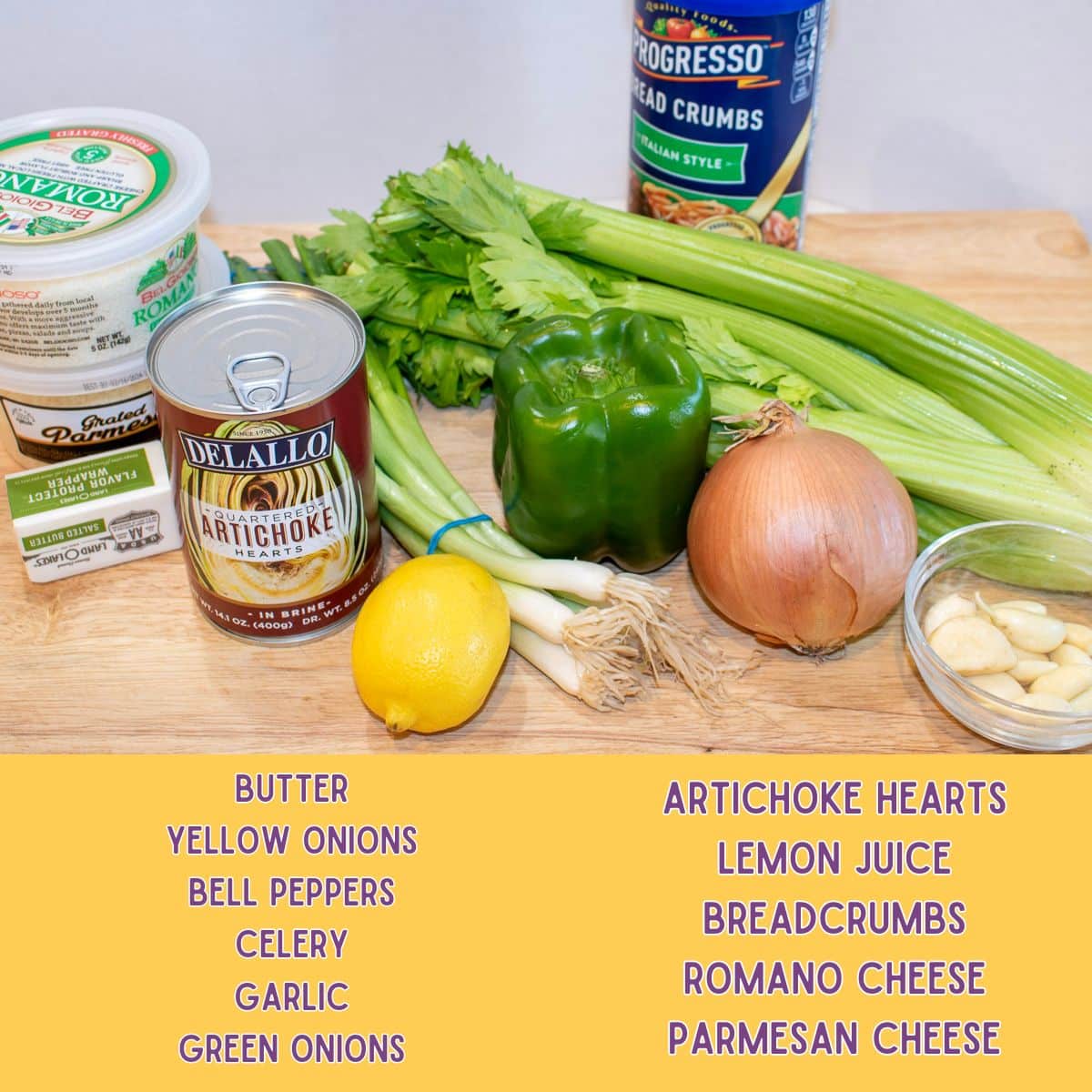


Ingredients Notes
- Mirlitons: Also known as Chayote Squash or Vegetable Pear. Scoop out the flesh and let it drain in a colander until you're ready to add it to the recipe.
- The Trinity: Yellow Onions, Bell Peppers, and Celey. This is the foundational seasoning for many Cajun and Creole dishes in the manner of the French Miropoix. You can substitute any sweet onion for the yellow onions.
- Artichoke Hearts: I developed this recipe using canned artichoke hearts in brine. I don't recommend using the artichokes in olive oil, but if you do, let them drain well or even rinse them before using.
- Breadcrumbs: I use seasoned breadcrumbs in this recipe, but plain breadcrumbs will also work.
- Romano and Parmesan Cheese: I use a mixture of both cheeses in the filling, plus a little parmesan in the topping. You could substitute any cheese you like, including asiagio, cheddar, or goat cheese. Of course, these will change the flavor profile of the original recipe, but these are your Artichoke Stuffed Mirlitons, so do it your way.
- Fresh Herbs: Since this is a vegetable-based recipe, I think Fresh Herbs are the way to go. I used fresh parsley, thyme, basil, tarragon, and marjoram.
- You can substitute, add, or subtract any fresh herb here that you like. Oregano and rosemary would be good options and I'm wondering how fresh mint would taste in this recipe.
- Make sure to finely chop your herbs and add them at the end.
- You can substitute dry herbs for any or all of these. Use about ⅓ to ½ less dry herbs than fresh herbs.
- Tarragon: This fresh herb can have a strong licorice flavor. In large quantities, it can be somewhat overpowering, but in small amounts (like I use here) it provides a nice and distinct background flavor. If Taragon is not your thing, leave it out.
- No meat or seafood: This recipe is not exactly vegetarian, but I developed it because I wanted to offer an option that did not contain meat or seafood. If you want to add shrimp, crab meat, sausage, beef, or pork, that's perfectly fine. Reach out to me if you want some guidance.
Equipment
A 12" cast iron or non-stick skillet is perfect for making this filling or stuffing.
Hints and Tips (FAQ)
Leftovers, if wrapped airtight, will maintain their quality for 3 to 5 days in the refrigerator or 5 to 6 months in the freezer. Let the stuffed mirliton cool down before refrigerating or freezing in an airtight container. They can be reheated, covered in aluminum foil, in the oven (350 degrees Fahrenheit) for about 20 minutes or until warmed all the way through. These can also be reheated in the microwave.
Let the mirlitons cool down, then place the fully baked mirlitons in the freezer on a baking sheet. Once the mirlitons are frozen, vacuum seal one to four stuffed mirlitons in a vacuum seal bag. This way, you will only need to defrost the number you plan to eat. If you do not have a vacuum sealer, pre-freeze the mirlitons as described above, then wrap each one in plastic wrap and a layer of aluminum foil. Place the individually wrapped mirlitons in a freezer bag and remove as much air as possible. Defrost overnight in the fridge and reheat in a 350-degree Fahrenheit oven for 20 minutes or until warmed completely through.
You can make this recipe a day or two in advance. If you plan to make this in advance, make this recipe up to the point that you stuff the shells, then place them in an airtight container in the fridge. When you are ready to bake, sprinkle the breadcrumbs/parmesan mixture with tabs of butter on top, and bake as directed.
Every bit of the mirliton is edible, including the skin and the seed. However, the skin is not as tender as its flesh, so when cooking mirliton in a casserole you should peel them first so that there is consistency in cooking.
Yes, they are. The mirlitons are a great source of many important nutrients, vitamins, and fiber. Read this article from Healthline about the benefits of eating mirlitons. Likewise, artichokes have many health benefits that are summarized in this Healthline.com article.
No, if you'd prefer not to stuff the shells, you can make a casserole out of the filling. You still want the mirliton flesh, so simply scrape off the peel after boiling, remove the seed, and chop the mirliton flesh. Prepare a baking dish by spreading softened butter all over the inside, then place the filling in the baking dish. Sprinkle the breadcrumb/parmesan mixture on top and place several pats of butter on top. and bake for 30 minutes in a preheated 350-degree Fahrenheit oven.
Here’s What You Do
First…you have a beer. If you prepare yourself and the ingredients, most of the work and all of the angst is over before you start cooking. To get in the right frame of mind, start by having a beer while you read the recipe all the way through. You will learn everything you need and know what to do with each ingredient. Then, perform your mise en place and get ready to make a great dish!
Mise en place
Preparing all the ingredients in the recipe before you start cooking will make the recipe go very well. You'll make sure that you have everything and that you don't forget to use any ingredients. Most of the work will be done and all you'll have to do is assemble the recipe.
To prepare the mirlitons:
- Slice mirlitons in half lengthwise.
- Place in boiling water for about 30 minutes until the mirlitons are very tender when probed with a fork.
- Remove the mirliton halves from the water and allow them to cool.
- When cooled, remove the seeds and discard.
- Carefully scoop out the meat leaving the shell for stuffing.
- Place the mirliton flesh in a strainer or colander to drain.
- Reserve the scooped-out halves for stuffing.
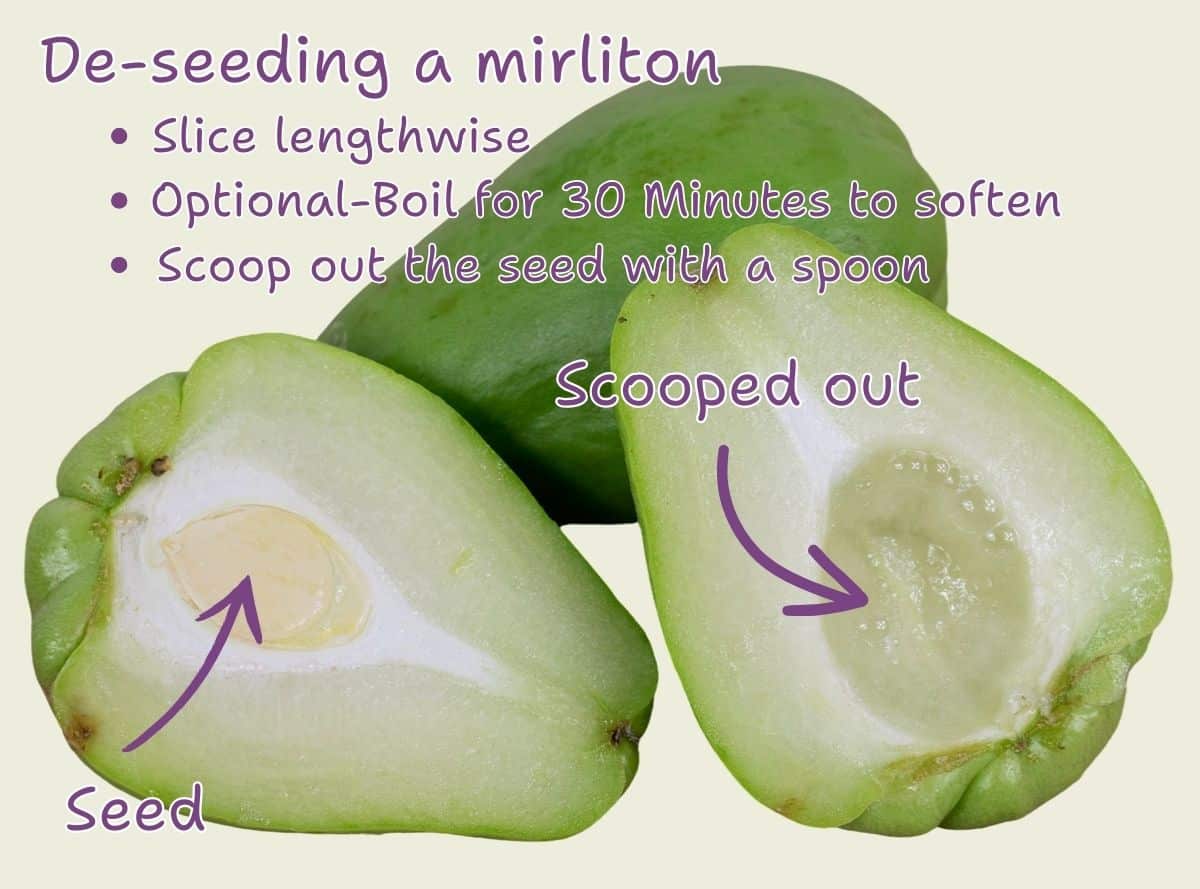
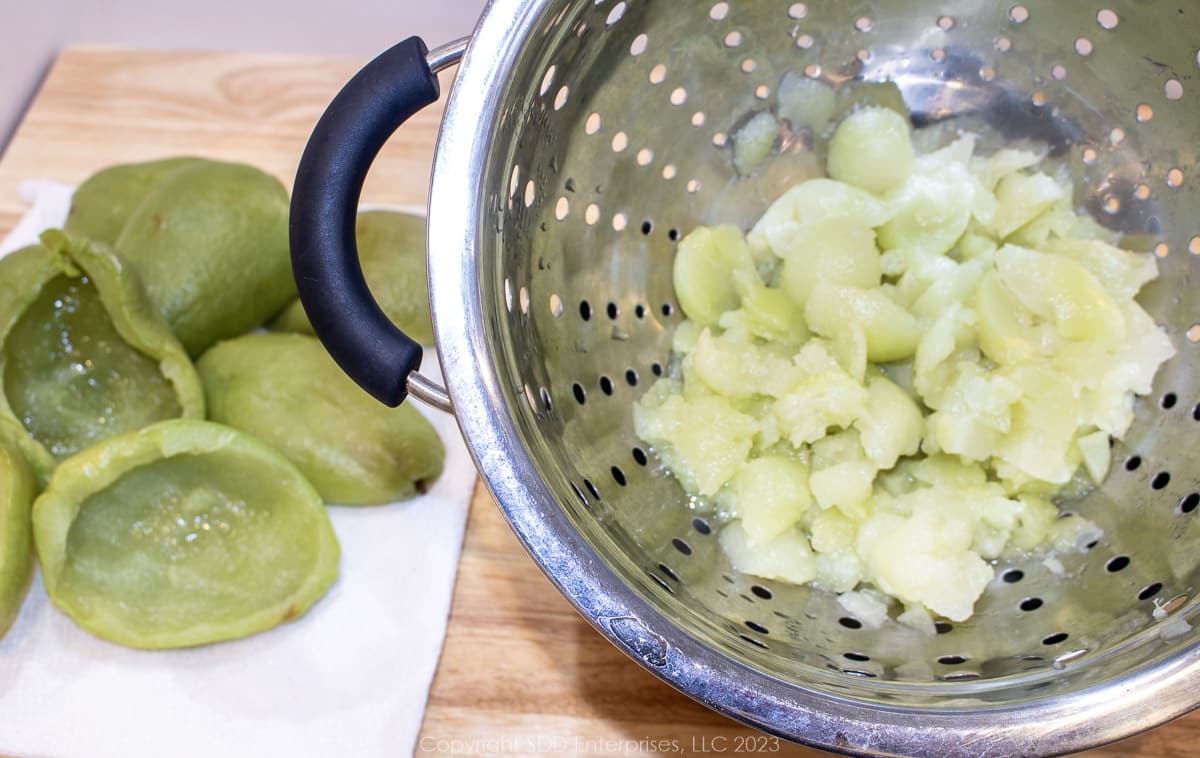
Sign up for my email notifications of new recipes and posts right HERE.
To prepare the remaining ingredients:
- Chop the Trinity (yellow onions, bell peppers, and celery) and place them in a prep bowl together. These do not need to be finely chopped, a rough to medium chop will do.
- Drain the artichoke hearts. Roughly chop them and place them in a prep bowl.
- Slice the white and green parts of the green onions and place them in a prep bowl.
- Roughly chop the garlic and place in a prep bowl.
- Grate the romano and parmesan cheese, if needed. Mix the cheese as directed. Mix the breadcrumbs and parmesan for topping.
- Squeeze the lemon juice and measure the butter.
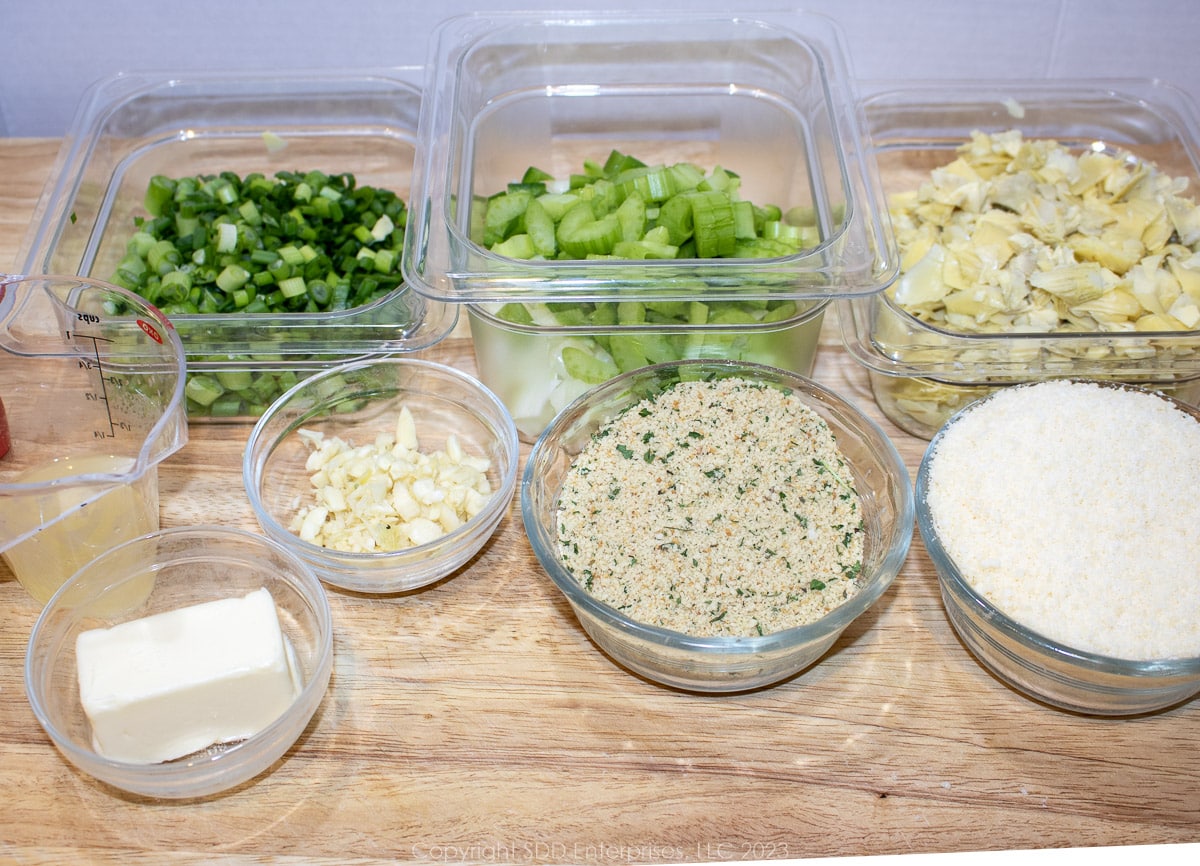
To prepare the Herbs and Spices:
- Measure the Creole seasoning and white pepper and place them together in a prep bowl.
- Measure the salt and place it in its prep bowl.
- Remove the stems from the fresh herbs and finely chop the leaves. Place them in a prep bowl together.
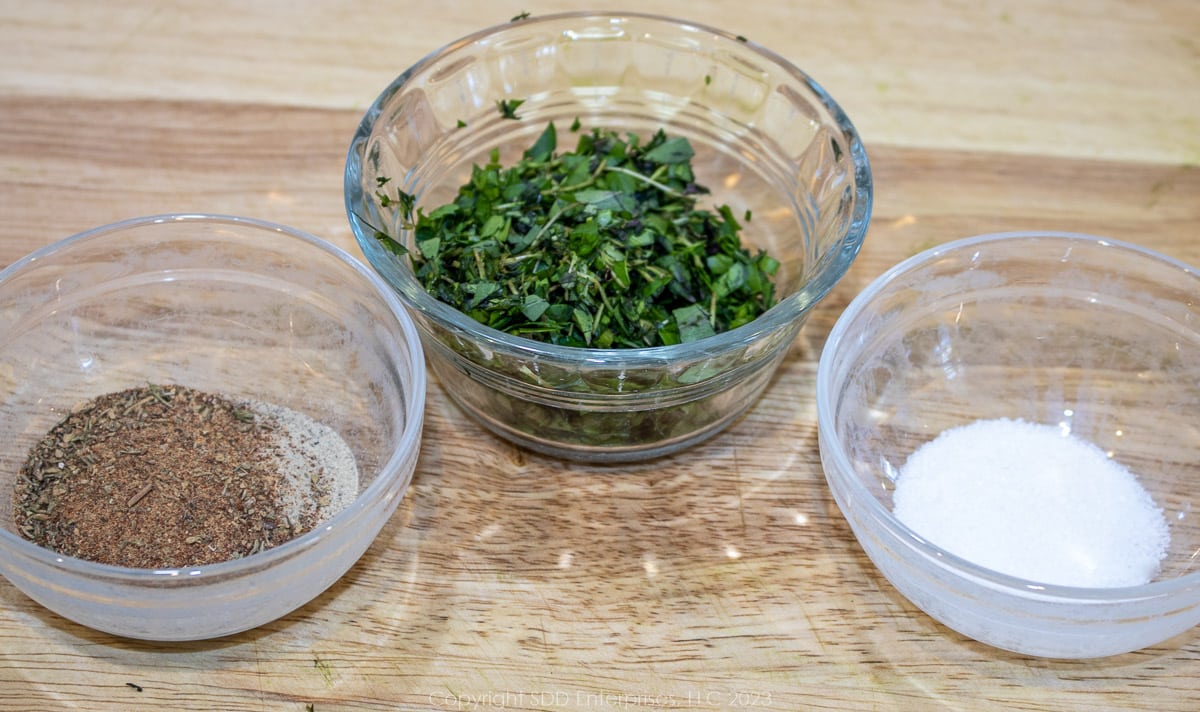
Saute the Vegetables
What happens in this step? The foundation of this recipe is the mixture of vegetables. Here we saute them slowly in butter to meld their flavors without browning.
- Place your 12" skillet over medium heat and add the butter. When the butter is bubbly, add the Trinity and saute it for about 8 minutes or until the vegetables soften and the onions become translucent.
- When the onions turn translucent, add the chopped artichoke hearts. Mix well and continue to saute all the vegetables for about 3 more minutes.
- Next, we will add some seasonings: garlic, Creole seasoning, and white pepper. Mix well and saute until the garlic is aromatic which only takes about a minute or 2.
- Now we add the drained mirliton meat with about ½ teaspoon kosher salt. Stir pretty constantly for about 5 minutes. Any liquid from the mirliton should cook off, but leaving some liquid is OK.
Lagniappe Tip: We do not want to brown the Trinity, just sweat the vegetables until the onions are becoming translucent.
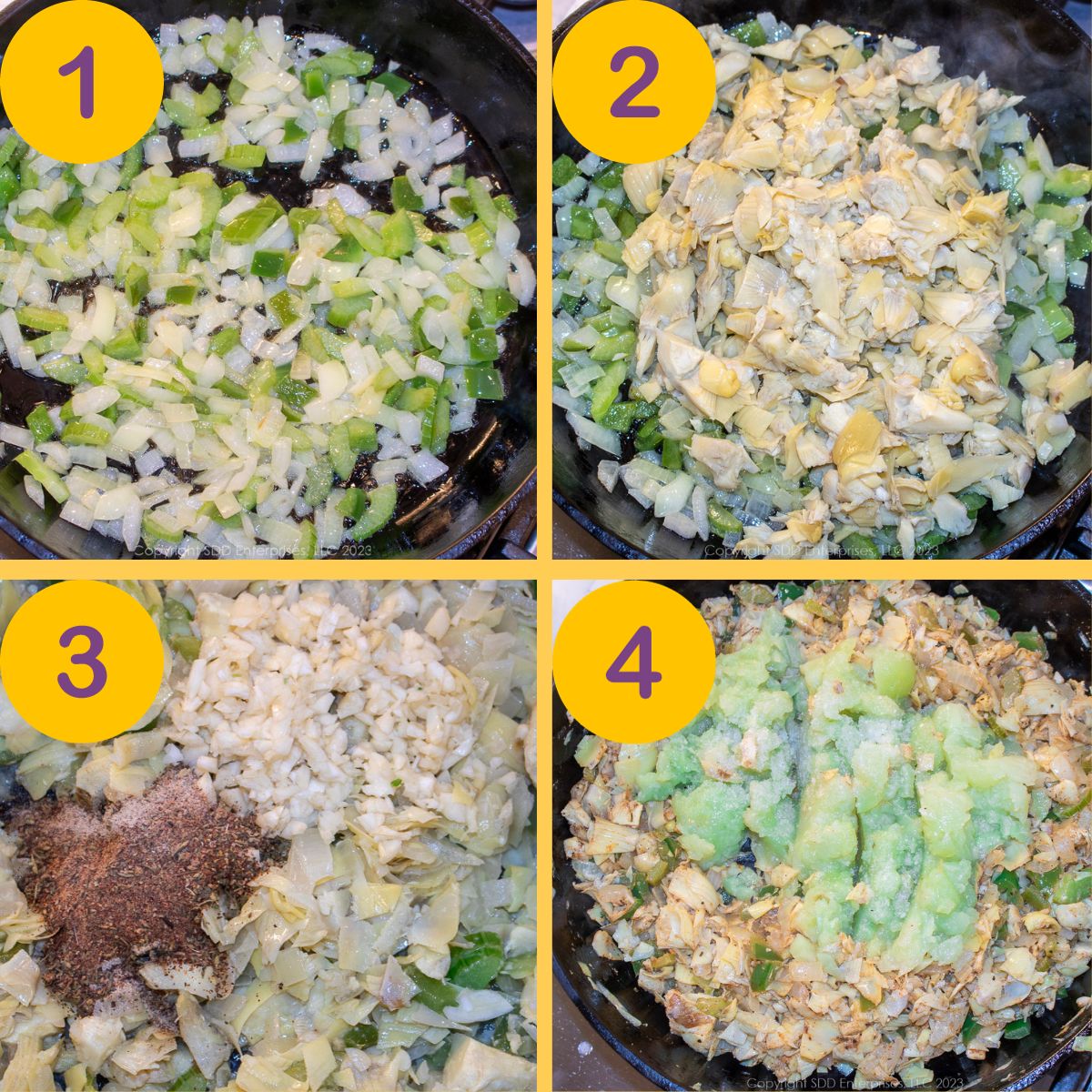
- Once the mirliton has been cooked into the other vegetables, finish this phase by adding the green onions. Stir well and saute for only about 1 more minute.
- At this stage, remove the skillet from the heat.
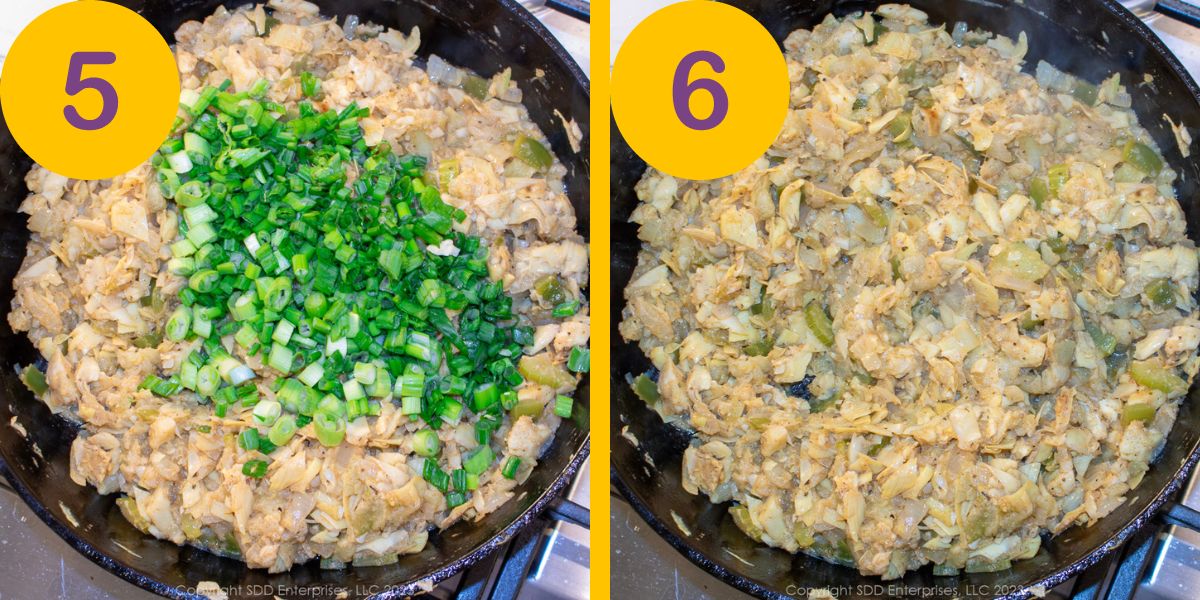
Add the Herbs and Binders
What happens in this step? Now that we have the foundation layer of flavor, we'll bind it together with grated cheese, seasoned breadcrumbs, and fresh herbs.
- Now it's time to mix the fresh herbs, lemon juice, and grated cheese with the veggies. Make sure to stir thoroughly to evenly distribute all of the ingredients.
- The stuffing needs to be tightened up a bit, so slowly add the breadcrumbs, starting with about half. Stir this into the mixture, then add more until you have the consistency you want.
- When everything is stirred together into a cohesive filling, let the stuffing sit for about 5-10 minutes while the breadcrumbs soak up any liquid in the vegetables.
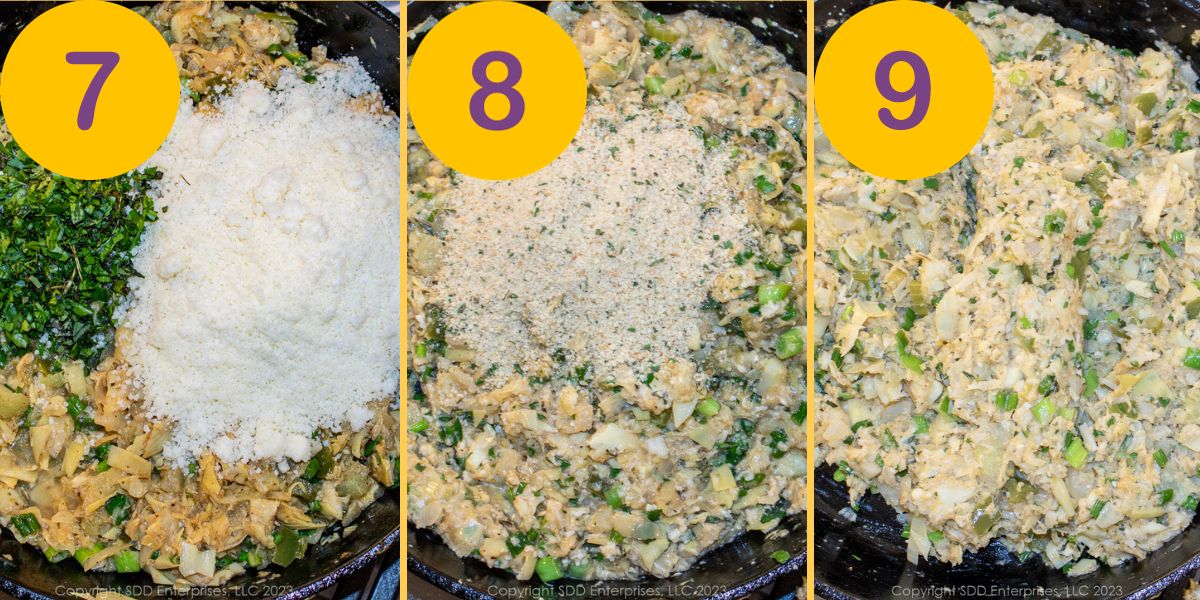
Stuff the Mirliton Shells and Bake
What happens in this step? Now it's time to stuff the mirliton and bake them to a golden brown!
- Use a spoon to fill the mirliton shells with filling. Make sure to press the filling down so that every void in the mirliton shells is filled and the top of the filling is nicely rounded. Place the stuffed shells on a prepared baking sheet or dish.
- Before baking, combine about 2 or 3 tablespoons each of breadcrumbs and parmesan cheese. Sprinkle this mixture lightly on top of each stuffed mirliton. Place two small tabs of butter on top of each.
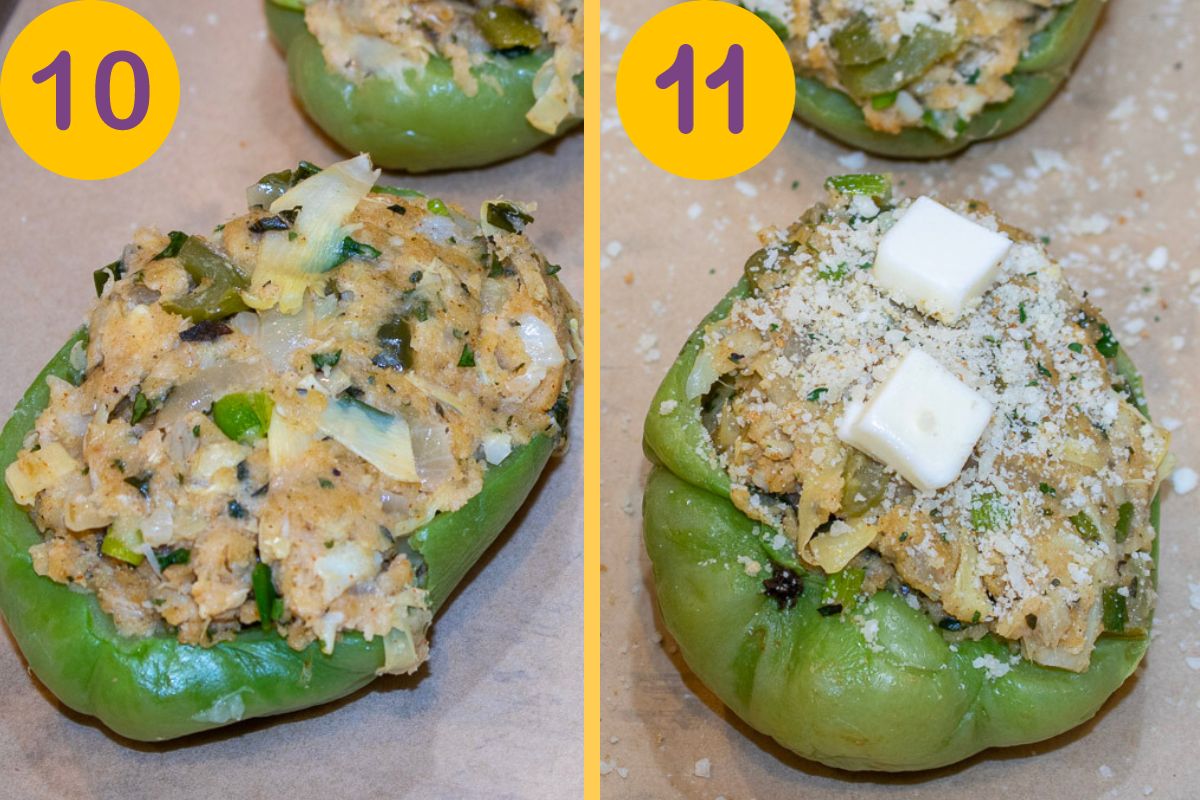
How to Bake Stuffed Mirlitons
Stuffed MIrlitons should be baked in a 350-degree Fahrenheit oven:
- Prepare the baking dish or pan with a thin layer of vegetable oil or oven spray.
- A baking sheet can be prepared by placing a sheet of aluminum foil or parchment paper on the bottom.
- Place the stuffed mirlitons in a prepared oven-safe baking dish, baking pan, or on a baking sheet.
- I have not found it necessary to add any water to the baking pan but feel free to add a little (¼ inch) if you want.
- These are usually perfect after baking for 30 minutes, but we are looking for the breadcrumbs and parmesan cheese to brown slightly and the butter to melt into the filling.
- Don't cover the mirlitons with foil unless you are reheating them.
- If you are reheating, allow them to sit out of the fridge for at least 30 minutes before covering them with aluminum foil and placing them in the preheated 350-degree Fahrenheit oven. Bake them for about 20 minutes or until they are heated all the way through. This will ensure you do not over-brown the mirlitons.
- Let the baked stuffed mirliton sit out of the oven for at least 5 minutes before serving.
Serving Suggestions
Stuffed Mirlitons can be a main dish or a side dish. These Artichoke Stuffed Mirlitons are a perfect side dish that will compliment many great main dishes. Here are some suggestions:

Some Other Great Mirliton Dishes
If you make this recipe:
- Tell us about it in the Comments section below
- LEAVE A RATING ON THE RECIPE-worthy of 5-Stars?
- Questions or Comments? that’s the place!
- SIGN UP FOR OUR EMAIL UPDATES so you don't miss anything!
- Post a picture and share it with your friends on our Social Media:
Yeah You Right!
Recipe

Artichoke Stuffed Mirlitons
Equipment
Here's What You Need
- 4 Mirlitons
- 4 Tablespoons butter plus some for the topping.
- 1 cup roughly chopped yellow onions
- ½ cup roughly chopped bell peppers
- ½ cup roughly chopped celery
- 3 Tablespoons chopped garlic
- 2 cups roughly chopped artichoke hearts
- 2 bunch green onions sliced
- 3 Tablespoons lemon juice
- 1 ½ cups seasoned breadcrumbs plus some for topping
- 1 cup grated romano cheese
- ½ cup parmesan cheese plus some for topping
Herb and Spice Blend
- 2 teaspoons Creole Seasoning
- 1 teaspoon white pepper
- 1 teaspoon kosher salt in all
Fresh Herbs
- 2 tablespoons finely chopped fresh parsley
- 1 tablespoon finely chopped fresh thyme
- 1 ½ teaspoon finely chopped fresh tarragon
- 1 tablespoon finely chopped fresh marjoram
- 1 tablespoon finely chopped fresh basil
Here's What You Do
- Slice mirlitons in half lengthwise. Place in boiling water for about 30 minutes until fork tender. Remove the mirliton halves to cool. When cooled, remove the seeds and discard. Carefully scoop out the meat leaving the shell for stuffing. Place the mirliton flesh in a strainer or colander to drain. Reserve scooped-out halves for stuffing.
- Add the butter to a 12-inch cast iron or non-stick skillet over medium heat.
- Add the Trinity (yellow onions, bell peppers, and celery) and saute for about 8 minutes until the vegetables soften and the onions become translucent.
- Add the chopped artichoke hearts and continue to saute for about 3 more minutes.
- Next, add the garlic, Creole seasoning, and white pepper. Mix well and saute for about 2 minutes.
- Add the reserved mirliton flesh and about ½ teaspoon kosher salt. Mix well and continue to saute for 5 minutes.
- Add the green onions and saute for about 1 minute.
- Remove the skillet from the heat.
- Add the fresh herbs, lemon juice, and grated cheese. Mix to blend.
- Slowly add the breadcrumbs, starting with about half. Mix well and add more until you have the consistency you want.
- Mix well and let the stuffing sit for about 5-10 minutes.
- Stuff the mirliton shells with the filling, pressing to make sure all the voids are filled. Place the stuffed mirlitons on a prepared baking sheet or baking pan.
- Combine 2 to 3 tablespoons each of breadcrumbs and parmesan cheese, then sprinkle lightly on top of each stuffed mirliton. Place two small tabs of butter on top of each.
- Place the baking sheet in a preheated 350-degree Fahrenheit oven and bake for 30 minutes or until golden brown.
- Remove the baking sheet from the oven and let the mirliton sit for about 5 minutes before serving.


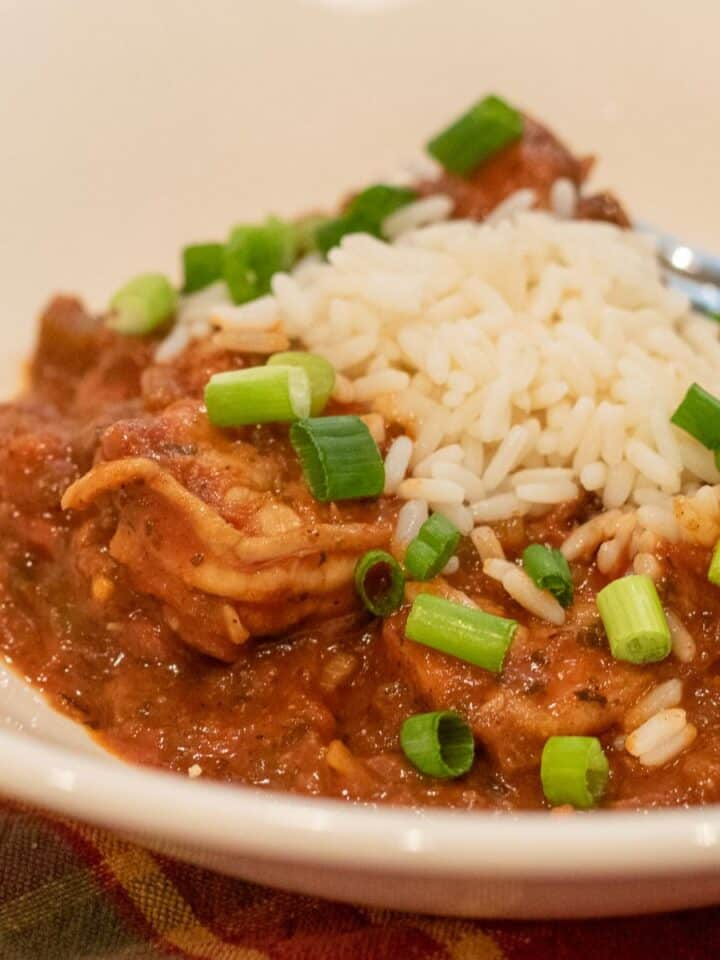

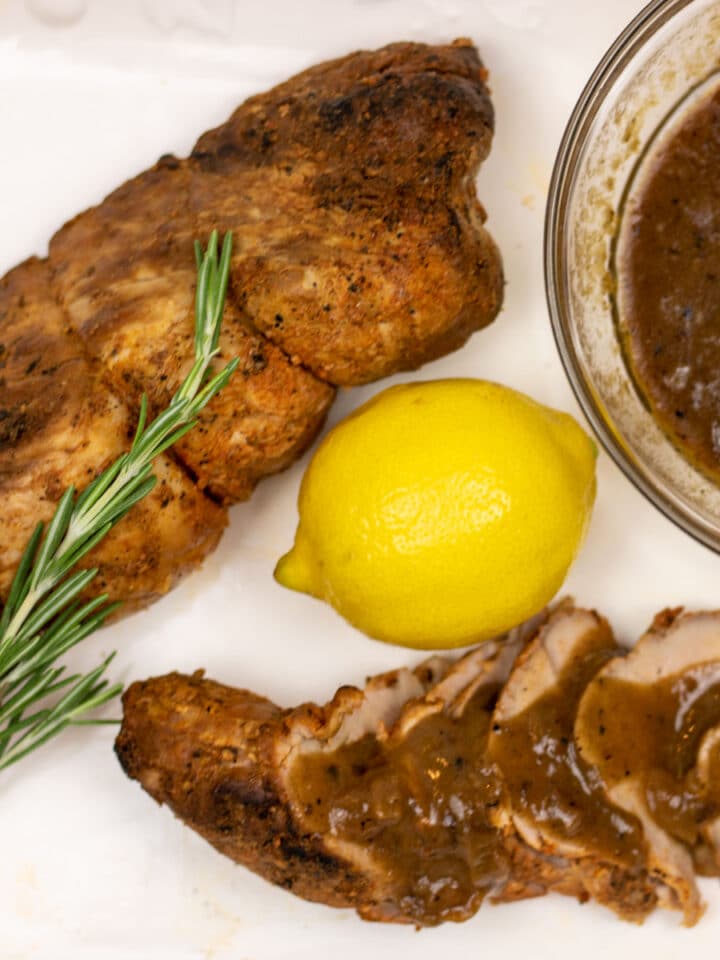



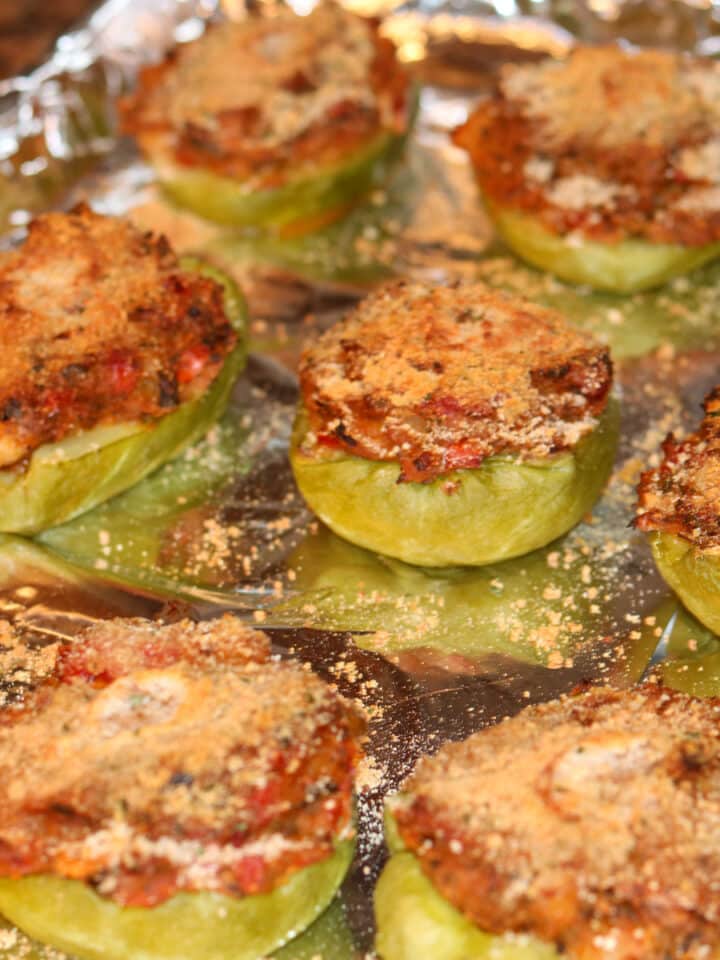

Patrick Miller
Going to do this recipe this weekend!
Sweet Daddy D
Great to hear, Patrick. Thanks!